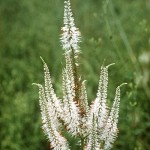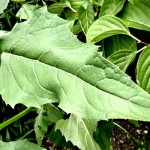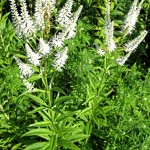Culver’s Root – Veronicastrum virginicum
|
Current Demand = GOOD |
Parts Used: Root |
 |
 |
 |
Family: Scrophlariaceae
Common Names: Culver‘s Root, Black Root, Culver’s Physic, Bowman Root, Tall Speedwell…
Description
Long stems extending 3 to 6 feet high topped with clusters of creamy white flowers in erect, slender, 9″ long spikes extending above dark green whorled leaves arranged in groups of 3 to 8. Flowers are crowded together all around each spike, blooming from the bottom up. They have no scent.
Growing Region: a very common plant in low meadows and damp ground in North America, extending from Nova Scotia almost to Florida and Texas through North Dakota. Usually found in moist black soil prairies, sand prairies, openings and edges of woodlands, thickets, savannas, and swampy meadows along rivers and ditches.
Harvesting/Drying:
Part used: Root
After harvest, the roots should be washed in cold water and foreign material (rocks, dirt and other roots) must be removed. Never soak roots in an attempt to clean them as this will extract vital alkaloids. Separate the stem from the root where the two meet at ground level. Unless the buyer is purchasing fresh dug roots (which they often do) the clean roots need to be dried. Culver’s Root can be dried in the sun, if possible dry indoors in a well ventilated barn loft or attic to protect from the elements.
If natural heat is not available, heat may need to be added and a fan added for continuous airflow. An old window screen or a wire mesh on a 2×4 frame works well for drying Culver’s Root. Also, it is a good idea to turn the roots daily as bloodroot holds an abundance of moisture and molds easily, the turning will help prevent molding. The key to drying herbs, roots or bark is an even combination of heat and airflow. Never dry in an oven or a microwave.
Cultivating
Planting: dividing rhizomes, tubers, corms or bulbs
Location: plants prefer rich moist soil in full sun to light shade grows best in medium to wet, well-drained soil in full sun. Growth is best in rich loamy soil, although some sand or clay is tolerated. The leaves may turn yellowish green in bright sunlight or during a drought. Medicinal Uses: laxative, treatment for fainting, treats kidney stones
Attributes (Images)
By Magnus Manske (Own work) [CC BY-SA 3.0], via Wikimedia Commons
By Crazytwoknobs (Own work) [CC BY 3.0], via Wikimedia Commons
 Root Buyer
Root Buyer